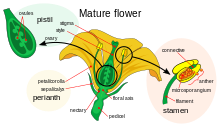
The perianth (perigonium, perigon or perigone in monocots) is the non-reproductive part of the flower, and structure that forms an envelope surrounding the sexual organs, consisting of the calyx (sepals) and the corolla (petals) or tepals when called a perigone. The term perianth is derived from Greek περί (peri, "around") and άνθος (anthos, "flower"), while perigonium is derived from περί (peri) and γόνος (gonos, "seed, sex organs"). In the mosses and liverworts (Marchantiophyta), the perianth is the sterile tubelike tissue that surrounds the female reproductive structure (or developing sporophyte).